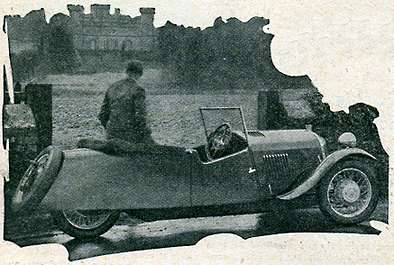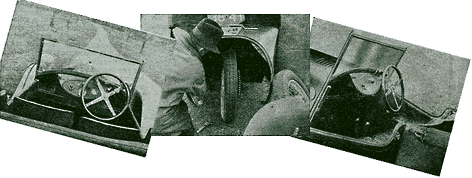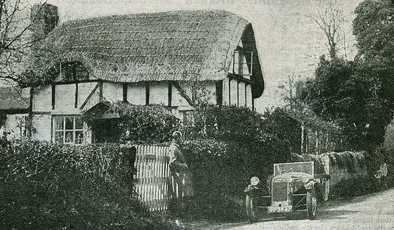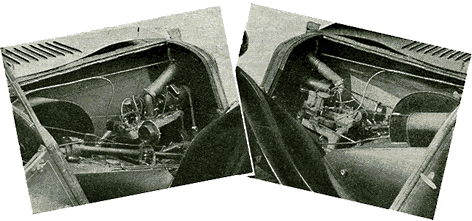An article, first published by:
Motor Cycling
May 09, 1934
pages 18 - 20
Road Test of 1934 Models
The Four Cylinder MORGAN
The First Road Test of an Interesting Three-Wheeler
THERE have recently been several interesting events in the three-wheeler world, but none more outstanding than the introduction of the four-cylinder Morgan, of which the first description appeared in Motor Cycling published on November 22 last.
Ever since that announcement, on the eve of the Show, inquiries have shown how eagerly a full road test report has been awaited. Owing to the demand for this new model, the Morgan factory was for some time unable to spare a production model for test, but Motor Cycling is at last able to publish the first of such reports on the Model F.

The first four-cylinder Morgan has a comfortable body built
upon sporting lines, and is powered by a 933 c.c. side-valve engine
of famous make. The price of this attractive three-wheeler is £120.
First, as to general impressions. Without any wish to be clever or funny, we can best describe this machine as being exactly like a Morgan with four cylinders. That is to say that apart from the more even pull and the different exhaust note of the four-bore unit, the Model F resembles other Morgans in most respects.
Like all Morgans, past and present, it is a man's motor; which statement, of course, does not imply that in this Year of Grace, 1934, it cannot be driven with equal ease and pleasure by many a woman.
This apparent similarity to other Morgans is at first rather surprising because from a technical point of view there are several notable points of difference between the two types. The chassis, for example, is entirely new and is built chiefly of pressed steel members, while the wheelbase is a foot longer than of the sister models. The front of the chassis, too, is laid out on a different structural plan.

| The interior of the body is roomy and the seats, the foremost of which are separate, are in close-couple formation. |
|
Attention to the rear wheel and chain of the Morgan Four is facilitated by a removable back panel. On the right is shown the general arrangement of the driving compartment. |
Yet a more thorough search shows that the characteristic features of the other Morgans are to be found also in this one. The independent front suspension with enclosed coil springs, the high-geared steering, the familiar transmission system and the rear springing with two quarter-elliptics and a substantial forged fork-all these are retained; and it will be agreed that every such feature has much to do with the feel of a machine on the road.
Although Morgans are by no means invariably driven at a high rate of knots, yet lively speed has always been among the primary attractions of the make. In this the Four is no exception.
Maximum Speed.
On several occasions its speedometer, accurate within the usual limits, recorded 70 m.p.h. Over a level quarter mile, the stop-watch showed a speed a little better than 65 m.p.h. (4,100 r.p.m.). Using the second ratio of 8 to 1, 48 m.p.h. (4,960 r.p.m.) could be attained without worrying the engine.
Even on top gear (4.85 to 1) the acceleration is definitely good and on second the Morgan almost jumps out of one's hands. Partly because of this, averages of 40 m.p.h. over normal journeys can be maintained without difficulty or danger.
Another point bearing on this matter is that the Morgan will cruise very comfortably at a genuine 55 m.p.h., equivalent to about 3,500 r.p.m. Even higher speeds, in fact, bring forth no signs of distress.
At the other end of the scale, the Four can be driven at 9 m.p.h. on top gear without snatch even with the driving chain comparatively slack. On second gear the minimum is 5 m.p.h. and on bottom gear 3 m.p.h.
Hill-climbing requires no particular comment. Only a really bad hill calls for a change down, unless it has to be approached at a low speed. In that case second gear will usually deal with the situation.
The Clutch.
In re-starting on a gradient some little care in clutch manipulation was necessary with the particular model tested. This is certainly not the fault of the clutch, which is particularly sweet. Since we must "speak as we find", that fact must be recorded, but it is only fair to add that a lower bottom gear will shortly be fitted to these models and so the difficulty should disappear. It is worth mentioning, too, that if necessary in hilly country, for instance, a 16-tooth sprocket could replace the standard 17-tooth one, so giving lower gears all round.
Petrol consumption with this, as with all vehicles, depends to some extent on the speed maintained. In the ordinary way 38 m.p.g. is obtainable. At high speeds this drops to 35 m.p.g. while 40 m.p.g. might be reached in gentle touring. Oil consumption is at the rate of 1,500 m.p.g.

The forward aspect of the Morgan is pleasing, the deep rearward sloping radiator
and graceful wings giving the machine an appearance which compares favourably
with modern sports cars.
Probably because of the longer wheelbase, the Model "F" rides even more comfortably than the twin cylinder Morgans. Satisfactory tyre pressures are 24 lb. per sq. in. for the back and 19 lb. per sq. in. for the front tyres.
A point worth watching is the lubrication of the sliding parts of the front suspension. This should receive attention every 500 miles or so, but it is desirable not to be too generous with the grease gun because over-lubrication reduces the damping effect which the slides have on the springs.
If too much lubricant is applied here, the Morgan may take to "prancing," but there is no real cause for worry in that. With too little damping, the front may bob up and down several times after striking a bad bump, but the excellent layout of the steering is shown by the fact that the wheels are not diverted from their course.
As a general and brief indication of the good steering a little experiment can be recounted. With the sliding axle gear distinctly over-greased, the Morgan Four was deliberately driven at over 65 m.p.h. along a bumpy road. Sometimes a pot hole struck one wheel, sometimes both together, yet throughout the proceeding the Morgan was controlled quite happily with one hand.
So there is nothing much wrong with it in that way. Similarly, the Morgan's cornering calls for no adverse comment. At the Malvern works, George Goodall gratuitously and voluntarily gave our tester full permission and encouragement to do his best to turn the car over! That no serious attempt was made to do so was due to the quite obvious difficulty of the task.
As to maintenance work generally, there is very little to he said. In the engine there is little more to be done than the addition of as much oil as may be necessary every 200 miles or so. There is a dipstick on the near side of the crankcase.
Of tappet adjustment there is none, for none is required. Strange but true. The plugs and the carburetter are very accessible, the latter standing well above the cylinder head.
By raising the back seat, the gearbox oil level can be checked with the dipstick provided. At the same time, the rear fork bearings and the driving chain can be lubricated and the battery inspected.
To adjust the chain is simple. First remove the spare wheel from the tail, by undoing two nuts and disconnecting the rear lamp cable. Next remove the tail panel by undoing four nuts. The wheel spindle nuts and the chain adjusters are then easily accessible. At the same time, the rear spring ends and the brake camshaft can be lubricated.
The Rear Wheel.
After the back wheel has been moved, it can be tracked up easily by ensuring that the rim edges on each side are equally distant from the fork arms.
Plenty of room is available for the storage of tools and other kit. Under each of the front seats - which, by the way, are adjustable fore and aft - there is a compartment several times as big as the average motorcycle tool box. In addition there is a smaller box on each side under the back seats. The tools provided are adequate to deal with all ordinary jobs and a jack is, of course, included in the kit.
As has been indicated, there are four seats. Those at the front are spacious but the back ones are intended more for children than for adults.

Both sides of the Ford 933 c.c. s.v. engine fitted to the Morgan Four.
The mountings of the Zenith down-draught carburetter and the Lucas dynamo
are noticeable features.
Besides the tool lockers already mentioned, there is a cubby hole for maps, etc., on the left of the instrument panel. The latter carries the speedometer, ammeter, lighting switch, coil ignition switch and tell-tale light, the starter switch and the starting control for the carburetter. This last provides a certain start from cold every time.
The starter, like the rest of the electrical equipment, is of Lucas manufacture. The dynamo, mounted above the engine, is driven from it by a belt and has an output of 10 amps. on full charge or 5 amps. on half charge at 45 m.p.h., and over quite a wide range on each side of that speed. With the lamps full on, the battery is just about "floating." The light given is good, but bright moonlight during the period of the test prevented any accurate measurement of the length of the headlamp beam.
Altogether an excellent job, this Morgan. It is already very popular and will be even more so.
The 4-Cylinder Morgan - Brief Specification
Engine: Side-valve Ford, four cylinders, 56.6 mm. by 92.5 mm. = 933 c.c.; "Silver Top" alloy head; 7 to 1 compression ratio; three-bearing crankshaft; gear-type oil pump (wet sump system); Zenith down-draught carburetter; Lucas coil ignition with automatic advance and retard; enclosed valves; sump capacity, ½ gal.
Transmission: Single dry-plate clutch; enclosed propeller shaft; three-speed and reverse gearbox; ratios - 4.85, 8.0 and 13.1 to 1, reverse 17.5 to 1; worm-driven cross-shaft and final chain to rear wheel. Dynamo beltdriven from front of engine.
Frame: Deep-section pressed-steel chassis with tubular backbone enclosing propeller shaft. Independent enclosed coil springs for front wheels; leaf springs at rear.
Wheels: 18-in. by 3-in. Dunlop Magna detachable and interchangeable wheels with 26-in. by 4-in. Dunlop tyres. 7-in. front and 8-in. rear brakes, interconnected to pedal; hand lever operates rear brake only.
Tank: Fuel tank under bonnet, capacity 5 gallons.
Dimensions and Weight: Wheelbase, 8 ft. 3 ins.; track, 4 ft. 2 ins.; ground clearance, 6½ ins.; weight (as tested), 9 cwt. 1 qr.
Controls: Spring steering wheel, with throttle-setting lever and dipping switch; accelerator pedal, brake pedal, clutch pedal; gear lever in gate; brake lever with ratchet for parking; on facia board: electric starter switch, horn button, ammeter, trip speedometer, ignition switch and tell-tale, lighting switch, instrument lamp and carburetter starting control.
Finish: Coachbuilt body with painted wheels; lamps, radiator, windscreen frame and hub caps chromium plated.
Price: £120, completely equipped.
Makers: The Morgan Motor Co., Ltd., Malvern Link, Worcs.
|


Did you come through the backdoor and now you are missing the navigation bar?
 If you don't have the navigation bar on the left side, pressing the
"Homepage & Index"-Button below will bring you to our homepage and will load the frame with the links for easy navigation.
If you don't have the navigation bar on the left side, pressing the
"Homepage & Index"-Button below will bring you to our homepage and will load the frame with the links for easy navigation.





